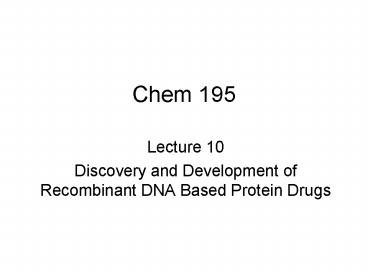Chem 195 - PowerPoint PPT Presentation
1 / 21
Title: Chem 195
1
Chem 195
- Lecture 10
- Discovery and Development of Recombinant DNA
Based Protein Drugs
2
Exam Summary
- Distribution of questions answered
- Everyone answered questions 2 and 5
- Only 6 people answered question 4 and only 4
answered question 6 - So I did a good job teaching patents and the
difference between in vitro and in vivo activity - And a bad job teaching basic enzymology
3
Project Proposal
- 1 page summary - Why And How
- Rationale, mechanism/pathway, and target you
would like to attack - Unmet medical need, market
- Can work in pairs
- Other components as listed previously
- List presently defined projects
4
Why Protein Drugs?
- Agonists and Antagonists
- Costs and Technology
- Catalysts and Hormones vs. Antibodies
- Replacement therapy
- Insulin - human vs. porcine
- Growth Hormone - recombinant vs. cadavers
- Next generation therapeutic
- Tissue plasminogen activator vs. streptokinase
- Recombinant Factor VIIIC vs. F8 concentrate
5
Proteins as Drugs
- Pre-existing examples
- Insulin - from pig pancreas
- Plasma products - clotting factors, albumin
- Streptokinase - clot lysis - from bacteria
- Issues
- non-human source - antibodies?
- Availability - would there be shortages?
6
Protein Drugs
- New technology - 1970s
- Recombinant DNA plasmid expression vectors
- Contain promoter for transcription, signals for
the initiation of translation, the human gene of
interest, stop signals - so-called expression
cassette - Also, need origin of replication and selectable
marker (usually antibiotic resistance) - Initially bacterial expression but subsequently
yeast, mammalian cells, and baculovirus infected
insect cells
7
Protein Drugs
- Biosynthesis and Regulation of Insulin
- Pre-Pro-insulin
- Signal-Peptide-B-C-A -gt BA
- What is the pro-insulin convertase?
- How to get from B-C-A to BA?
- Dibasic specific proteases
- carboxypeptidase
- How to get 2 chains?
8
Insulins
9
Protein Drugs
- Genentech solution - E.coli expression
- Make two chains separately and put together
- Issues its tricky to get the right disulfide
bonds - Thermodynamics and kinetics
- Second generation - make proinsulin (Lilly)
10
Protein Drugs
- Chiron solution - yeast secretion
- Yeast alpha-mating factor processing
- Similarities to insulin (dibasic processing
sites) - Make 1 chain with a mini-C peptide
- Alternate processing enzymes (kex-2)
- Clue to furins - PI convertase family
- Steiner on proinsulin convertase
11
Protein Drugs
- Growth Hormone
- Secretion from E.coli
- Processing to eliminate N-terminal Methionine
- Identification of Methionine amino-peptidase
(Cetus) - Previously obtained from cadavers - issue with
Creutzfeld-Jacobs disease (slow virus -
resembling BSE)
12
Protein Drugs
- Hemophilia A
- X-linked trait
- Most common genetic disease
- Large fraction arises spontaneously but some
inherited - Known to be deficiency of FVIII but as of 1983
the molecular structure of FVIII unknown - Site of synthesis also unknown
13
Protein Drugs
- FVIIIC
- Monoclonal antibodies used to purify protein
using a clotting assay in F8 deficient plasma as
a detection scheme - Protein sequencing followed by genomic library
screening with degenerate probes using a 4X
genome library - Alternative approach to porcine FVIII
14
Protein Drugs
- FVIIIC
- Three way race, Genentech, Genetics Institute,
Chiron - Papers published in 1984/5
- Very complex molecule and very large gene (186
kB, 9 kB cDNA) - Proteolytic processing to activate (thrombin) and
inactivate (protein C)
15
Protein Drugs
- Previous FVIII - pooled from many blood donors
- Led to a whole generation of hemophiliacs
becoming HIV and HCV positive - Scandals on lack of blood screening tests,
especially in France
16
Protein Drugs
- New/Old Proteins with New Indications
- Interferon alpha and beta
- Interferon-alpha - originally described as
antiviral substance - First approval for treatment of hairy cell
leukemia - Later became major treatment for Hepatitis C
(although it doesnt work that well) - Interferon-beta used exclusively for treatment of
multiple sclerosis - IFN-alpha and beta work through the same receptor
systems - still not clear why they work
differently for different diseases.
17
Protein Drugs
- Two most profitable protein products
- Erythropoeitin - red blood cells
- Granulocyte Colony Stimulating Factor - immune
cells - Both stimulate blood cell production
- Used as adjunct to cancer chemotherapy
- EPO also used by athletes to promote oxygen
capacity (illegal - blood doping)
18
Protein Products
- Deficiencies in First Generation Protein Products
- All agonists - all injectables
- How to improve properties?
- Increase potency
- Increase pharmacokinetics
- Decrease degradation
19
Protein Drugs - the Next Generation
- Next Generation Protein Therapeutic Agonists
- Aranesp - mutant EPO
- Glycosylation sites and receptor binding site are
distinct - Increased glycosylation leads to longer half-life
- Increased sialic acid glycosylation from 3 sites
to 5 - Enabled Amgen to get a molecule which they didnt
have to share with JJ
20
Protein Drugs - the Next Generation
- Next Generation Protein Therapeutic Agonists
- PEG-IntronA/Pegasys - pegylated IFN-alpha
- Pegylation increases half-life
- Thus, decreases dosing schedule
- Next generation tPA - TNK tPA
- 4 amino acid changes
- Moved glycosylation site by 2 mutations (T103N,
N117Q) - increased in vivo half-life - Mutated 4 residues KHRR 296-299 to AAAA
- 100 fold resistance to PAI-1 and improved fibrin
selectivity
21
Protein Drugs
- Summary
- New technology (cloning and recombinant DNA based
expression) enabled production of human proteins - Agonists which replaced old products or were new
ones - Second generation products via protein
engineering led to molecules with improved
properties, especially in vivo half-life































